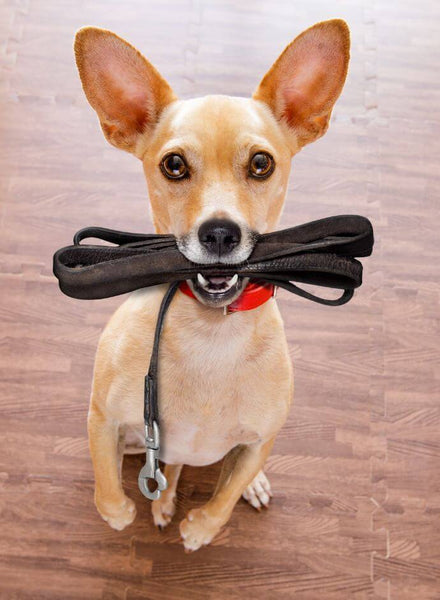5 Reasons Why Dogs With Separation Anxiety Need Exercise
For many dog owners, dealing with a dog’s separation anxiety can be difficult.
An anxious dog exhibits distress and panic when left alone.
This often leads to destructive behaviour and excessive barking.

There are a variety of ways to manage separation anxiety.
Still, one overlooked yet beneficial solution is regular exercise.
Join us as we explore five reasons why exercise is vital for canine separation anxiety.
5 Reasons Why Dogs With Separation Anxiety Need Exercise

1. Alleviates Stress and Anxiety
Like humans, dogs get stressed and anxious.
Regular exercise is a natural and effective way to reduce these feelings.
Exercising releases endorphins, which are the body's natural mood elevators.
When dogs engage in physical exercise, they experience a reduction in stress hormones.
Thus, this makes them calmer and more relaxed.
For dogs prone to separation anxiety, exercise provides an outlet for pent-up energy.
Also, exercise helps prevent the build-up of anxiety while pet parents are away.
Try out our anti-anxiety dog bed which can serve as a safe place for your stressed and anxious pup.
2. Promotes Mental Stimulation
Exercise also provides valuable mental stimulation.
Activities like walking, running, or playing fetch engage a dog's senses.
These pursuits keep their minds occupied and prevent boredom.
Mental stimulation is crucial for dogs with separation anxiety.
Mental exercise through puzzle toys helps distract them from feelings of distress.
Toys filled with tasty treats or peanut butter can serve as preventative measures.
By adding mental exercises, pet owners can help their dogs develop coping mechanisms.
3. Enhances Bonding with Owners
Engaging in physical activities with your dog strengthens your bond.
Spending time together through exercise fosters trust, communication and companionship.
For your canine companion, this bond adds to their comfort and security.
Attentiveness to their needs can lessen feelings of abandonment.
Additionally, the sense of routine can provide reassurance to anxious dogs.
This also helps them feel more secure in their environment.
4. Reduces Destructive Behaviour
A challenging aspect of separation anxiety is dealing with negative behaviour.
From destructive chewing to excessive barking, these behaviours can be frustrating and costly.
Regular exercise offers a constructive outlet for a dog's energy.
Exercise reduces the likelihood of destructive behaviour occurring if you’re away.
5. Improves Well-Being
Regular exercise is vital for maintaining a dog's health and well-being.
It supports cardiovascular health and strengthens muscles and joints.
Exercising also aids in weight management, and boosts immunity.
Dogs with severe separation anxiety often experience physical symptoms like gastrointestinal issues.
Thus, promoting physical fitness and health can lessen the symptoms of separation anxiety.
Related: Simple Tips To Improve Your Senior Pet’s Life
Exercises That Help With Your Dog’s Separation Anxiety
Several types of exercises can help ease separation anxiety in dogs.
Some exercises that can help are:
1. Walks:

Try to go for at least one brisk walk per day.
Focus on leash walking to encourage focus and obedience.
A long walk is also the best way for your Fluffy Friend to explore their surroundings.
2. Interactive Games:
Play interactive games like fetch, hide-and-seek, or tug-of-war.
These games help keep dogs mentally stimulated and active.
They provide an outlet for excess energy.
Also, they can serve as positive reinforcement training.
Interactive toys, puzzles, and treat-dispensing chew toys can mentally engage dogs, too.
3. Agility Training:
Agility training exercises provide both physical and mental stimulation for dogs.
This type of training builds confidence and improves coordination.
Setting up a backyard agility course can be a fun and rewarding way to engage with your dog.
You can also ask for a training program from a certified professional dog trainer.
4. Scent Work:
Dogs have a keen sense of smell, and scent work activities can stimulate and enrich them.
Hide treats or a food toy around the house or yard and encourage your dog to use their nose to find them.
You can also try more advanced scent work activities.
Tracking exercises are good choices which provide mental challenges and build focus.
5. Swimming:
Swimming is an excellent low-impact exercise that provides a full-body workout for dogs.
It's particularly beneficial for your four-legged friends with medical issues like joint pain.
Swimming is also refreshing for dogs, especially during hot weather.
Related: 10 Dog Breeds With Low Separation Anxiety
6. Group Playdates:

Organising playdates with other young dogs can provide socialisation opportunities for your dog.
Group play allows dogs to interact and practise social skills.
It also helps burn off excess energy in a safe and supervised environment.
Additionally, positive interactions with other dogs can help reduce anxiety and build confidence.
7. Obedience Training:
Incorporating obedience sessions into your dog's routine can help reinforce positive behaviours.
Training sessions provide mental stimulation and establish a sense of structure.
It’s a good idea to focus on basic commands such as sit, stay, come, and down.
Try to incorporate impulse control exercises to help your dog develop self-control.
When designing an exercise or training plan, think about their individual needs.
Try to consider their preferences and physical limitations and start slow.
Afterwards, increase the intensity and duration of your pooch’s exercise sessions.
Still, always prioritise safety and supervision, particularly when trying new activities or exercises.
8. Desensitisation and Counterconditioning:
Exposure to triggers paired with good experiences can help dogs form positive associations.
Try to leave for short periods of time and make sure to give rewards after.
Then, you can increase the duration of absences.
9. Behaviour Modification:
A certified separation anxiety trainer can aid with behaviour modification techniques.
A trainer might recommend desensitisation exercises or counterconditioning protocols.
10. Calming Exercises:
Try out deep pressure therapy (through the use of a weighted blanket for example).
You might also try playing calming classical music to soothe your dog.
Reminder:
Be consistent, patient, and positive when doing any training or behaviour modification program!
Related: How to Stop Your Dog's Excessive Barking

Conclusion
There you have it, our five reasons why dogs with separation anxiety need exercise.
Your dog’s anxiety is a serious condition but you can help your dog deal with stress through exercise.
By adding regular exercise into their routine, you can help them cope better with being alone.
Go ahead and embark on a journey to a happier and healthier life together!
Looking for some products that could help you out?
Check out our Online Shop!
Here are some useful products in relation to this blog post:
